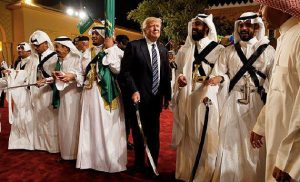
Under US President Ronald Reagan and his vice president and successor, George H. W. Bush, the situation was complicated further by the Iran-Contra scandal, in which senior Reagan administration officials secretly facilitated the sale of arms to Iran between 1985 and 1987, despite an arms embargo. As a result, when the relatively moderate President Akbar Hashemi Rafsanjani took power in August 1989, ended Iran’s war with Iraq, and put out feelers to the US, Bush’s hands were tied.
Rafsanjani eventually re-launched Iran’s nuclear program, with recovery from the war with Iraq facilitating progress. But it was the hardline Ayatollah Ali Khamenei, who had succeeded Ayatollah Ruhollah Khomeini as Supreme Leader in June 1989, who steered the country in that direction, by plunging relations with the US into a near-total freeze. The efforts of President Bill Clinton’s more pliable administration to bring about a thaw were repeatedly rebuffed.
Then the tables turned. When the moderate President Mohammad Khatami took office in 1997, it was the US that was headed in a more hardline direction. After the September 11, 2001, terrorist attacks on the US, President George W. Bush denounced Iran as part of what he called an “axis of evil.” And yet, by invading Iraq in 2003, the US under Bush gave Iran its greatest historical opportunity for westward expansion. In 2005, the renewed dream of Iranian regional hegemony helped bring to power President Mahmoud Ahmadinejad, who pursued the nuclear program with vigor.
In 2013, Ahmadinejad was replaced by Rouhani. With President Barack Obama already in office in the US, conditions were ripe to take a few steps forward. After nearly two years of tortuous negotiations, the agreement to halt Iran’s nuclear program, in exchange for the gradual lifting of economic sanctions, was concluded.
Nonetheless, Trump has vowed to scrap the deal, with his advisers citing the same arguments that emerged during the ratification process. But, with the exception of Israeli Prime Minister Binyamin Netanyahu’s government and its supporters, virtually no one supports such a move.
Unilateral US abrogation of the agreement would not be easy. After all, the deal was the result of negotiations involving six major powers, including, unusually, China and Russia. France, Germany, and the United Kingdom – America’s principal European allies, none of which is likely to re-impose sanctions without good reason – also participated. Even Saudi Arabia, representing other Arab countries, grudgingly approved. The US Congress, initially resistant, has largely come around.
Iran’s bitterest regional enemy, Saudi Arabia, would move rapidly toward a nuclear capability, using abundant petrodollars and Pakistani knowhow. Others – Turkey, Kuwait, Egypt, and Algeria – would not be far behind. To bet that these countries, having acquired such weapons, would behave responsibly would be a high-risk gamble.
Compounding the threat posed by US withdrawal from the nuclear deal, Iran is currently beset by uncertainty. When Rafsanjani, the patriarch of Iran’s moderate forces, died in January, his funeral was the occasion for one of the largest demonstrations in the Islamic Republic’s history. With the elderly Khamenei suffering from cancer, the battle to choose a new supreme leader is not far off.
In short, the world cannot afford the breakdown of the Iran nuclear deal. If Trump attempts to resume America’s pas de deux of the past with Iran, the result may be a dance of death.
Source: Project Syndicate